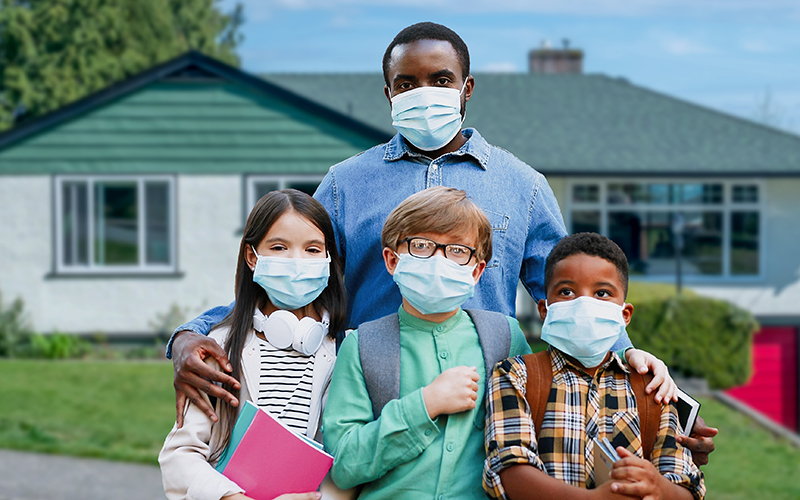
by Kari Tanta, PhD, OTR/L, FAOTA, Children’s Therapy Clinic
Pandemic pods? What are those you might ask? Perhaps you are experiencing feelings of anxiety or anger related to a current situation that involves a remote learning model to start the school year. If you’ve heard about learning pods, you may feel they are something out of reach for you or perhaps inaccessible to you related to your situation. These are very real issues for families with school-aged children this fall. In response to questions our Children’s Therapy staff members have been receiving lately, the intent of this article is neither to endorse or denounce learning pods, but rather to provide some information for families who are interested in the concept. Please take the information that is helpful as you think about the needs of your children, your family, and the successful school year we all want for all children in our community.
What is a pod? The word pod, according to the Merriam-Webster dictionary, is “a number of animals (such as whales) clustered together” or “a protective container or housing.” In the context of the care and education of children, pod means clustering our children to protect and nurture them. At its core, this is what the concept of the pandemic pod is all about.
What is a pandemic learning pod? Pods during COVID-19 have also been referred to as bubbles. We have heard about bubbles in numerous contexts over the past 6 months—bubbles for housing, for get-togethers, for work, for childcare—the learning pod or bubble is the latest in this series to gain attention and in many instances, it’s also closely tied to childcare as parents struggle to balance childcare, work and schooling. The goals of these pods can vary, but may:
- Provide childcare
- Provide opportunities for kids and families to socialize
- Provide support for children who need help using technology or finishing lessons
- Provide enrichment such as science, art, physical activity or music
How are pods formed? Pods may develop casually between friends, family members, and or neighbors who share similar values related to COVID-19 and their response to the well-being of their own family. Often these pods or bubbles are formed when families have frank conversations about their behaviors (such as mask wearing and following public health guidelines) and they all agree to follow the same health behavior guidelines in order to safely interact with each other. Schools, community groups, and private businesses are also getting involved in the concept of pods and it is likely we will see more of this in the days, weeks and months ahead.
Are the school districts working on pods? While it is outside the scope of this article to address the plans of each individual school district in our area, we know that this is a topic of conversation among local educators. For example, the superintendent of Seattle Public Schools was recently quoted as saying, “We know that our families across the city are going to need assistance.” She also said they are working with community organizations to provide families with alternatives to pods. More information related to Seattle’s plan can be found here. You are encouraged to visit your school district’s website for more information on what support resources are available for you and your child.
Where do pods happen? The more common pods become, the more varied their form and locations will be—there is no “one-size-fits-all” pod. Some locations of pods may be:
- Private homes, usually in a large room or basement
- Outdoors, parks or playgrounds
- Private businesses
- Community centers
- Churches
Do you have to hire a teacher or a tutor to have a pod? While some families may hire a trained teacher or tutor, you can be part of a successful pod experience that meets the goals of your family and child without a hired educator. Parents, other adult family members, friends and neighbors all can make excellent pod supervisors. Some pods use a system of rotating days, academic subjects or activities. This can be a great way to use the special skills we all have to benefit the children around us. Other possibilities for part-time tutoring are the college students who are now living back at home with their parents and high school students who need volunteer hours—there might be one in your neighborhood who would love to help for little or no cost!
What ages of children typically form a pod? Pods may be made up of any combination of ages, depending on the goals of the pod. They may include children of similar ages or children of mixed ages. Pods with younger children may need more adult support, while pods of high school students may be run without adults and run more like a study group (from pre-COVID-19 days!).
How do I set up my own pod or join a pod?
- Talk with your child and other family members about the goals for pod participation
- Identify individuals within your social circle who share similar health practices around COVID-19 safety
- Explore opportunities within your community that may meet your pod needs (church, YMCA, Boys & Girls Clubs, scouting, school district)
- Explore social media for opportunities—many Facebook pages have been set up for like-minded families related to learning pods
- Explore these links to essential step-by-step guides to forming a pod during the pandemic:
Whatever your child’s school experience ends up being this fall, rest assured that with your love and support they will have a “pod experience” even if you don’t call it that. Long before COVID-19, our kids had pods of parents, teachers, specialists, friends and neighbors who all helped to shape their educational experience. New name, same concept, more technology, lots of hand sanitizer…points to ponder for sure!

